I never heard that before! With that comment about a passage whose relationships he had just become aware of, a gifted student began to evaluate a piece by Brahms as "beautiful" instead of "just nice." In just this way many differences in "aesthetic judgment" really arise from disparities in perception.
Certainly other arts are beset by inexperienced or uninterested persons who are unaware that both aesthetic response and taste cannot legitimately be based on inadequate perception. Developing perception—using the senses and then thought to connect what has been sensed into meaningful, related units—takes practice and ability.
For example, someone with a limited intellect may appreciate the sets and activity of a play, but the text would be reduced to a babble. Intellect and training—both formal and informal—allow us to combine language's sounds into words, to group words together, and to relate appropriate groups. Perception of content in any of the arts requires the same (conscious or intuitive) intellectual process. Therefore, an in ability to notice what a work of art contains cannot support a judgment about it.
Confusion about the importance of perception in music is partly due to the ease with which we recognize loudness, tempo, and a recurrent beat or figure, for instance; the hearing of these traits elsewhere leads to the mistaken idea that all has been heard in more demanding pieces as well. Clearly missing, however, is the perception of (for example) the more imaginative melodic and harmonic continuities.
Developed through thought, theory, and custom, harmonic systems in Western music are self-referential and self-regulating (e.g., in tonal music, V7 chords and dissonances want to resolve in prescribed ways for no reason other than usage). Therefore, though the "rules" of tonal harmony may indeed be arbitrary (i.e., culture based), they are as binding as the rules governing sports; and perception of any music—but especially more challenging works—requires hearing the operative relationships of the system, and since composing processes and aesthetic criteria also derive from the culture, and since composers use the systems creatively, the ability to distinguish the usual from the unusual.
Learning to listen, therefore, means gaining an awareness of banality, of expectations and of the delight and limits to surprise (e.g., an unmotivated event is far different from Beethoven's sudden but prepared shift to D-flat in measure 557 of the first movement of his third symphony). It also means learning taste, as defined in our culture. E.T. Cone's claim that some reasons for "liking the tunes" are "beyond analysis" is limited, simply by "it sounds better" being a sensible criterion only for adequate perceivers.1 Of course, if analysis could explain everything we would all know what to do and we would do it; but the "mysteries of art" exist well beyond what can be taught and demonstrated to most auditors. While the commonplace occurrences they are used to are too often preferred by the inexperienced, the results of imagination are what "sound better" to the ear and mind that have learned to be perceptive.
Confusion also arises from focusing on programs, as if the music along with its associations causes the desired response, thus fostering the idea that musical worth is related to programing. Transferred and further conditioned by background music for movies and television, this attitude leads to the imagining of private fantasies being taken as the appropriate—and thorough—approach to hearing works by such composers as Mozart and Schoenberg. It leads to the odd notion that absolute music is only "intellectual"; but as we learn to perceive music's own content, we learn that Bach and Brahms can be expressive too.
Additional confusion results from some "judgments" being only ostensibly about music; many people listen to music, not for aesthetic enjoyment, but for reasons like sentimentality, sexual stimulation, escapism, an induced mindlessness, relaxation in dentists' offices or supermarkets, or because of ethnic pride, in which case a work may be esteemed not for an intrinsic expressivity but because it contains ethnic referents that evoke Pavlovian reflexes. The use of music as a mood-inducing accompaniment to other activities and the inclusion in discussions of artistic value of extra-musical considerations cloud our minds. What should, but may not be self evident is that aesthetic value depends on a work's specifically musical content. Therefore, since too few people perceive such content adequately, general popularity cannot be a gauge of aesthetic worth.
For example, in order to fulfill its proper functions, popular music must be easy to hear and have only common musical relationships. Typically, the use of current vogues is confused with creativity; but comparing popular music either to jazz, with its greater rhythmic, melodic, harmonic and textural inventiveness, or to works by Chopin or Babbitt shows popular music's paltry use of the possibilities of composition and harmony. It may appeal to the herding behavior of adolescent "peer groups," to the need to adore performers or to the desire to have the commonest physical or emotional aspects of our lives stroked, but considered just as music, the patterns and procedures of popular music are too easily grasped and well-worn.
Of course, we can all "like" (and few of us can escape) vulgarity; but since popular music requires so little musical perception from its auditors, how would they become sensitized to the ways in which the content of subtle and complex works are organized? Degrees of sensitivity, intelligence, experience and interest vary. For some people casual aesthetic experiences suffice; others actively seek more contact with the most intense uses of a medium, and as a result develop finer abilities and responses. For people thus interested in music as music, their continued involvement is most demanded and rewarded by works in which a great deal more is going on than just dynamics, tempo, and repetition; after repeated hearings the music makes sense to them on its own terms. "Taste" founded on faulty perception should not, then, be confused with critical evaluation; rather the concerns should be with the sensibilities of those who adequately grasp musical content (or the medium-specific content in any art) and with helping those who want to become more interested, informed and adequate perceivers.
Within its (and our) limitations, musical analysis can both improve perception and demonstrate the application of aesthetic criteria by discussing the content that makes some pieces aesthetically satisfying—details that most competent listeners probably take for granted—and the musical structures and compositional criteria that create aesthetic delight.2
Relating analysis to evaluation is problematic because, for diverse reasons, professionals do disagree. But art is multivalent. For example poetry is praised when it invites diverse but complementary interpretations.3 Since great music also has such richness, the time to worry is when the work does not yield variant interpretations. The idea that one explanation exhausts the multiple possible relationships of a well-composed musical work is a prime example of pedantic pettiness.4 The complexity of much of Mozart's music, for example, is covered by a surface simplicity and elegant economy. To believe that only one interpretation suffices, that "this is what Mozart really meant"—and all that he meant—is to presume that "my" comprehension and musicality limits the extent of everyone's, including Mozart's.
At least when they are adequate, variant analyses ought to be considered complementary. Before being too quick to call an analysis inadequate, it is best to remember that some disagreement is essential. First, a work that unresistingly yields invariant results is probably so obvious as not to require analysis at all. Second, while some works may resist analysis because they resist making sense, invariant analyses of a work within the "common practice" system lead to the suspicion that it is barely distinguishable from others in the same style and is therefore of little intrinsic worth or aesthetic interest. It is the unique work that continues to intrigue.
Whatever differences follow from variations in musical training and character—and as trained musicians know, views change with experience, study and growth—they occur within a set of generally accepted judgments made by generations of composers, performers, teachers and listeners about the received repertoire. Such agreement among those interested in music must be because a work's relationships and the aesthetic principles that generate them are customarily noted, with varying effectiveness, by adept (lay or professional) listeners.5 As we listen we do analyze the music, usually intuitively.
"Intuition" is an intellectual process too fast for verbalization.6 Composers intuit what "wants" to come next and improve this sense with training and use. Experienced listeners intuitively gather a lot of information, process it and make relevant relationships virtually instantaneously. This is what analysis does too, but the discussion is slower and unilinear. Analysis is done consciously; but since most analysts also have left and right brains, more adept analysts make intuitive discoveries as well. Thus aesthetic judgments are not "pre-analytic."7 A sentence in a familiar language is understood only when its syntax is analyzed, i.e. only when experience and use have shown how grammar affects meaning. We learn a language's "rules" mostly informally, as we learn its vocabulary. This lets us formulate new sentences "naturally," intuitively taking grammar into account.
Similarly, an experienced painter intuits the possibilities of transforming a landscape into a composition with proportions and interactions he has learned to esteem. With competent observers, therefore, liking and critical judgment can coincide; but while judgment should be objective (i.e., demonstrable), liking may still be affected by learned preferences, acquired biases or psychological attitudes. Even allowing for subjective differences (i.e., not those opinions that stem from inadequate perception, limited experience or intelligence, deficient ear, background or interest, but those that result from varying temperament or training), a more adept perceiver can at least make judgments that are better informed and that have a better chance of being reasonable.
Determining whether musical relationships and corresponding aesthetic evaluations are demonstrable requires a description of the aesthetic attitudes that pertain to the body of literature being considered. In Western cultures:
I. The arts are considered medium-specific. In poetry the "sound" should "echo the sense."8 In painting, accurate representation rather than composition is taken as a criterion only by the uninformed; and pieces of music that rely heavily on only their programs have short lives. Therefore, competent listeners value the medium for its own sake, understand the possibilities of the harmonic system being used, of composing processes and of the style of the work, and bring into the experience not associations but a set of learned expectations.
II. Uniqueness is valued. Since events they are accustomed to neither engage nor require their attention, competent observers expect and will recognize original and memorable shapes and unusual events (e.g., in the minuet of Haydn's Symphony No. 104 in D, only listeners who mark the recurrent downbeat react to the humor of its absence); and they value specificity, assuming that one choice is best, even inevitable sometimes, and preferring economy and direction to meandering and uncaused events.
III. "Best choices" are identified with subtle, complex and elegant, sometimes expressed as deceptively simple, thought; with imagination instead of pedantry and pedestrianism, and since a paucity of relationships obviates the need for the prolonged, intense perception that is most satisfying, with a rich multivalence that distinguishes a well crafted work from a merely competent one instead of simplistic choices.
IV. Craftsmanship is identified with change and growth. Therefore, competent observers expect a continuity of inventively varied melodic shapes that they will relate to each other; they pick up harmonic implications and distinguish between predictable successions or "effects" imposed upon or inserted into a work and developments of the work's own material; they re-experience a work, not only to enjoy its richness again, but to discover more of its internal relationships; they anticipate when telling events occur and recur in a work, relate similar works to each other and to the body of pertinent literature, thus having some bases for judging levels of creativity.9 Having already discovered motivic variation, they can distinguish between the levels of thought used in Three Blind Mice and Mozart's Symphony No. 39 in G Minor. Consequently they expect structure to be not over-obvious, projected inventively and imaginatively, with elaboration (the identifying traits of a work) and embellishment (a repertory of conventional, common property figurations) that must not be over-used.
For example, in Schubert's Heidenröslein, the voice's opening BA background motion, DA descent and return to D lead to an event that both surprises and prepares for further developments: the use of the higher instead of the lower G (Ex. 1).
Ex. 1. Schubert: Heidenröslein

The background is expected to continue from A, probably to the lower G (see Ex. 2), but the choice of the higher G allows the DG ascent to compensate for the DA descent;
Ex. 2. Bach: Aus meines Herzens Grunde
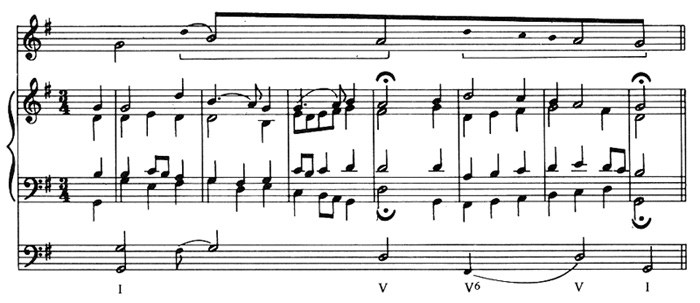
then the D that starts both of these fourths becomes tonicized (at the word "Freuden"): and the next rise further incorporates the higher register into the song, with the first G dissonant (measure 10) and then a peak (measure 12, on the word "Roth") just before the cadence.
A comparison (Ex. 3) shows how the use of the more obvious lower G creates a line that, unlike Schubert's, has no special qualities and therefore sets up no distinctive continuities.
Ex. 3.

With the fulfilling and generative octave transfer, however, plus the song's other uncommon details (e.g., the precisely chosen chords and dissonances, the changing phrase lengths), the song's simplicity becomes deceptive. The elegance seems natural and is aesthetically satisfying.
Occasionally a variant version, useful for comparison with a known work, already exists in the literature. The "Themes" of "La Confession" by Michel Corrette (1709-1795) and of the first movement of the Sonata in A Major, K. 331 by Mozart, are very similar and are both the bases for variations. The Mozart theme provokes analytic and performance questions. Example 4 shows the basic motion in measures 1-8.
Ex. 4.

The treble E, less stressed in measure 1, prepares for its realization, in measures 9-12, as 5; the lower levels return in measure 11; and in the concluding phrase, the 5 moves stepwise to the A (1) of measure 18.
Considering motives, the first two statements (measures 1-2) each have one chord and last one measure; the statement starting in measure 3 is completed only with the C-sharp of measure 4, and is accompanied by faster chord changes. The fourth statement, measure 4, is inverted and rhythmically compressed, both melodically and chordally. The "tension" of the phrase occurs in measure 3, because of the delay in reaching the awaited C-sharp, the quicker harmonic rhythm and the use of dissonance. Thus two equally long motivic statements occur in the first half of the phrase and are balanced in the second half by two more, but the first one is longer and the second one shorter than the motive's referent length. The result is an elegant asymmetry within symmetry (Ex. 4a).10
Ex. 4a.

Also, the density created in measure 4 by both the shortening of the motive and the use of parallel thirds gives weight to the idea that the soprano's local motion is EDC-sharpB (measures 1-4), while the parallel alto level moves C-sharpBAG-sharp.
The second phrase, measures 5-8, is no mere repetition; measure 8's cadence resolves measure 4's; and in measure 7 the motion seems faster because the motive, instead of lengthening to correspond to measure 3, is now made just less than a measure long. In the again varied concluding "A" of the A-A-B-A form, if the motion in measure 16 went directly to A, as shown in Example 5, the conclusion would be abrupt and inelegant and would lack the weight necessary to bring the upper level's line down in measure 16 from the D to the C-sharp and then to the tonic. Also, the foreground rise in measure 17, combining two motivic thirds into a sixth, delays and thus intensifies the arrival of the expected A.
Ex. 5.
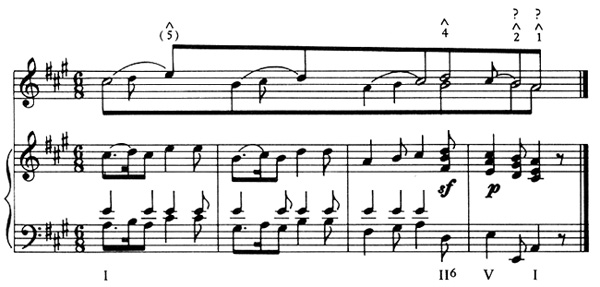
The "tag" ending, measures 17-18, is a necessary continuation from the 5 of section "B" and the 4 of measure 15, prepared for by the stressed D in measure 7, to the concluding 3-2-1 motion.
The suggestion is that the melody's upper background line can be interpreted in two complementary ways: 3-2, 3-2-1 as an alto or middle level in measures 1-8 and (5) 5-4-3-2-1 as a soprano or upper level in measures (1) 9-18. The diversity of possibilities ought not to be thought of as a weakness in the piece (or in the analysis, I hope) but as a sign of an intriguing multivalence. Also intriguing is the possibility of variance in performance.
The dissonant E in measure 4 embellishes the D and thus varies the motivic ascending third to a descending fourth that is also a summary of the EDC-sharpB motion (if the E is considered the start of this level) in measures 1-4. A phrasing suggested by one of my professors (Ex. 6) would bring out both the motive and the latent fourth formed by the E ending the first statement and the B starting the next.
Ex. 6.

This fourth prepares for the explicit EB descent of measure 4 (and in measures 1-4). Another professor maintained with equal cogency that the phrasing shown in Example 7 would best express the motivic and structural relationships here and would have the added value of keeping the fourth latent, implying but saving it for later use. The reader can decide.
Ex. 7.

When re-experienced, this "simple" tune shows its richness. Compare now the "Theme" of Corrette's piece. Where Mozart has the E of measure 1 heard only within a chord (I moving to I6), creating the ambiguity of whether the 5 or the 3 begins the background's upper level, Corrette supports the second E with a return to I
moving to I6), creating the ambiguity of whether the 5 or the 3 begins the background's upper level, Corrette supports the second E with a return to I ; and in measure 2 he again moves to a chord in root position. In Mozart's piece the descent from the first E is a local motion, the C-sharps of measures 1 and 3 are linked, and the alto level controls this melodic structure; also, the density is increased in measures 3-4. In Corrette's piece, in contrast, if the descent from the stable E (5) in measure 1 is an upper level motion, then from the C-sharp of measure 3 on, the two levels are joined. This loss of a voice lessens the intensity (Ex. 8).
; and in measure 2 he again moves to a chord in root position. In Mozart's piece the descent from the first E is a local motion, the C-sharps of measures 1 and 3 are linked, and the alto level controls this melodic structure; also, the density is increased in measures 3-4. In Corrette's piece, in contrast, if the descent from the stable E (5) in measure 1 is an upper level motion, then from the C-sharp of measure 3 on, the two levels are joined. This loss of a voice lessens the intensity (Ex. 8).
Ex. 8. Corrette La Confession
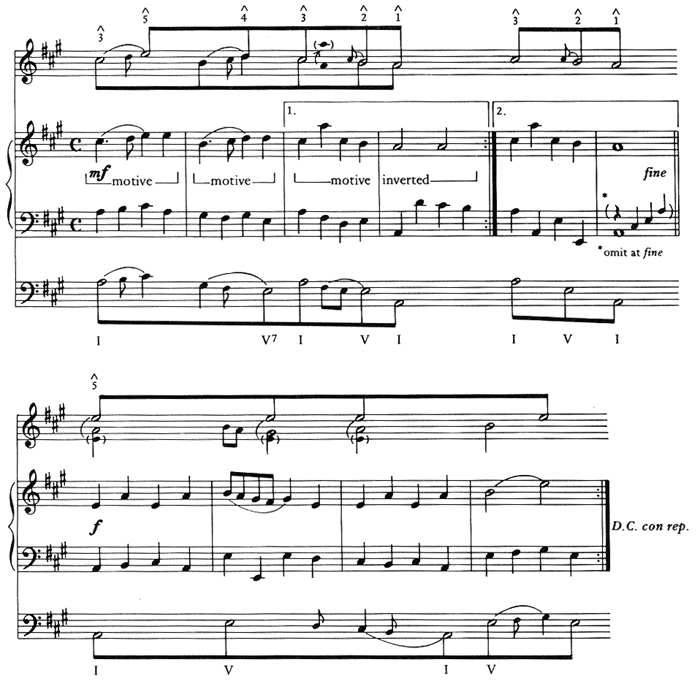
The sequence is also less intense; as with Mozart, measures 1 and 2 here each have a measure-long motivic statement; but measures 3-4 have a single inversion (or retrograde) that lasts two measures. Therefore, Mozart both extends the melodic motion at the "phrase-climax" and then as compensation quickens it. Corrette slows it down for both the climax and the cadence.
To counter this, two events build the instability needed: chords change faster and the A is transferred an octave higher. However, unlike Schubert's use of this technique discussed earlier, this high A is unmotivated and unprepared, has no consequences and could be readily replaced by the lower A (Ex. 9).
Ex. 9.

The redundancy of the two treble levels in measures 3-4, the immediate completion of the background line in the first phrase, the graceless insertion of the octave displacement and the lack of melodic invention all contribute to the tune's inadequacy. It should be no surprise that compared to Mozart's work, the tune is overmatched.
For the rest of the "Theme": the second phrase (measures 5-8) merely repeats the first one's melody, with the chords in measures 7-8 even more basic than those in the corresponding measures of the first phrase (measures 3-4); the "B" section uses only the commonest I and V chords, offering no harmonic relief, and the concluding period of the form is a repeat of the first. However, it should be noted that the octave transfer of the E in measure 12 is handled better, for the motion from B up to E is prepared by the E-A's of measures 9 and 11 and compensates for the BE descent in measure 10. In comparing the variations written on the "Themes" by the two composers, Corrette composed only two, using only what many similar pieces do, while Mozart as usual filled his six variations with originality.
Analysts usually try to show what makes a piece good. Using an analysis of Mendelssohn's "Second Venetian Gondola Song," Opus 30, No. 6, from the Songs Without Words, to show what the piece lacks, however, may only show a flawed analysis. The risk of thus paying for one's hubris becomes acute when the preferred analysis differs from the master's. Yet Schenker's analysis of this piece does present problems.11
First, it is hard to accept the unstressed A's of measures 1 (bass) and 9 (treble) as the beginning 3 of the "Urlinie's" soprano level (Ex. 10).
Ex. 10.
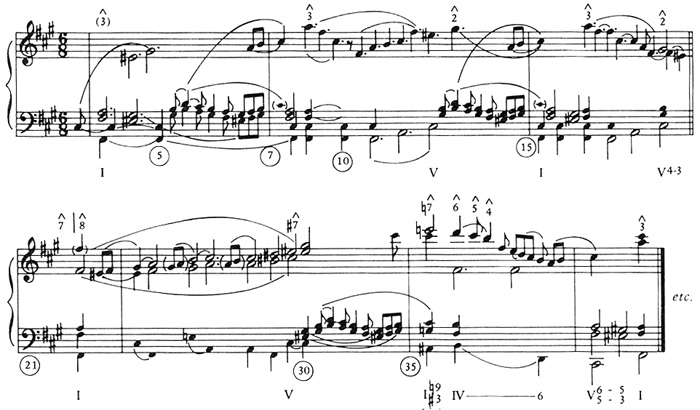
Would not the duration, repetition, metric stress and I support suggest that the C-sharp of measures 7-8 is this level's 5 (Ex. 11)?
support suggest that the C-sharp of measures 7-8 is this level's 5 (Ex. 11)?
Ex. 11.
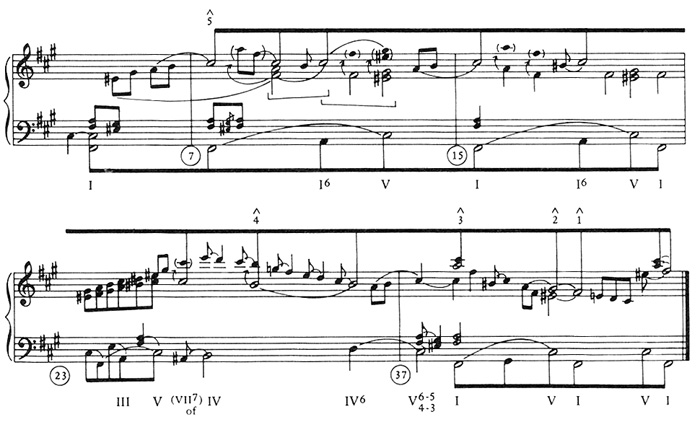
Moreover, Schenker's analysis lessens the importance of the change of harmonization in the reprise, where the unstable  chord for the C-sharp (measure 37) along with the I
chord for the C-sharp (measure 37) along with the I support of the A (measure 39) would define this A as the soprano's 3. Could not the A at the piece's start be an alto level 3 that moves to 2 (G-sharp) in measure 13 while the C-sharp remains unreplaced in the soprano?
support of the A (measure 39) would define this A as the soprano's 3. Could not the A at the piece's start be an alto level 3 that moves to 2 (G-sharp) in measure 13 while the C-sharp remains unreplaced in the soprano?
Second, to keep the A as the soprano 3 from the start, Schenker explains the B in measures 35-36 as part of a descending scale (Ex. 10). But the IV chord of measure 35 is, after continuous I's and V's, the only harmonic change in the piece. It is tonicized, the B in measure 36 is ornamented, the re-entry of the bass supports this B and it is the arrived-at note of a ligature. Would this conflux of events be too meager to support the B as 4 (Ex. 11)? Moreover, if the A remains as 3 from measures 1-42 and the arrival at IV (and 4) in measures 35-36 is not a structural motion from the opening 5 to the reprise's 3, then the piece is more static than I perceive it.
This is not to say that no craftsmanship is evident in the piece, e.g., the treble C-sharp in measure 12 is the center of two inversionally related triads, the tonic and the dominant (does this further support the C-sharps background berth?); the length of the second phrase (measures 15-21) is reduced by a measure while the melodic motion is intensified by the sequential descending scale in measure 18 that impels the line to the low F-sharp; the deflection of the bass at measure 33 from the expected I to a VII7 of IV leads to the climactic IV chord in measure 35.
But the expectation for inventiveness is under-fulfilled. The retained F-sharp in the bass makes measures 3-4's E-sharpG-sharp strikingly dissonant, and when the melody enters (measure 7) the repetition in the left hand is omitted and the dissonant chord from measure 3 is used, thus quickening the harmonic rhythm and setting up for a development of these dissonances. That is, in music and the other time arts, the effective use of an idea followed by a less interesting form of the same idea causes aesthetic disappointment. Yet the E-sharpG-sharp that were pungent dissonances subsequently become less evocative consonances, e.g. in measures 13-14 and 20. And while measures 23-30 could be a realization of what these two notes imply, the straightforward scale, from the lower to the higher E-sharpG-sharp, has no harmonic newness. (Compare how Chopin relates the F-flat to the section in E Major in his Mazurka in A-flat Major, Opus 17, No. 3.)
Instead of the imaginative development of unusual events, common-place harmonic relationships are used throughout. For example, the "B" section expands V, with the bass line outlining the tonic triad to arrive at the V of measures 29-30; but the chords used are most readily available from tonality's common repertory (the V of III, and the VII of V0, nothing like what is suggested by the opening; and the motive used, from the melody's first three notes (measures 6-7), is both unvaried and unvarying. (Compare Chopin's Prelude in E Minor, Opus 28, No. 4, or the Mazurka in F Minor, Opus 68, No. 4.) Even the typical inflecting of III in measure 26 is too fleeting to be a fulfillment of the A in the bass of measures 12 and 19. Also, only the I and V chords are used until measure 25; and then at the piece's climax, the other primary chord, IV, is used.
of V0, nothing like what is suggested by the opening; and the motive used, from the melody's first three notes (measures 6-7), is both unvaried and unvarying. (Compare Chopin's Prelude in E Minor, Opus 28, No. 4, or the Mazurka in F Minor, Opus 68, No. 4.) Even the typical inflecting of III in measure 26 is too fleeting to be a fulfillment of the A in the bass of measures 12 and 19. Also, only the I and V chords are used until measure 25; and then at the piece's climax, the other primary chord, IV, is used.
Therefore, the relationships and avoidance of common banality show that the applicable aesthetic system still values skill and imagination. The piece would certainly suffer if no unique events occurred; but there is too little density, too little inventive use of the piece's own materials. The piece promises more than it gives.
Compare how much is contained in the first 19 measures of Mozart's Fantasy in D Minor, K. 397. Since one deficiency of analysis is that it deals with a piece after it has been composed, perhaps it might be useful to work from the background, speculating as details are added about the aesthetic bases for some of the choices.
Example 12a is an ordinary projection of the basic opening I-V motion, with a soprano, rising and then compensating, and a most simple bass creating some instability that the cadence resolves. Durations are assigned to increase the rate of change just before, and return to the referent duration at the cadence. Example 12b adds inner voices, uses occasional dissonances, and adds a penultimate bass note to avoid the static ending.
Ex. 12.



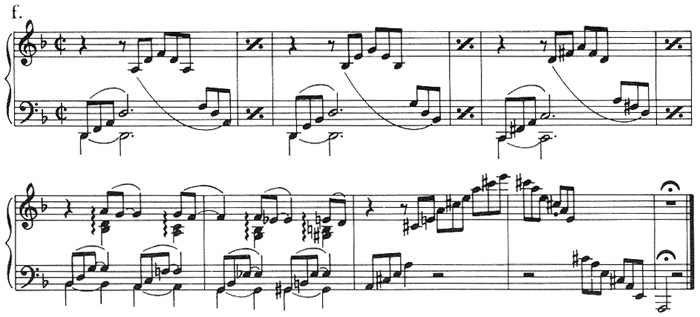
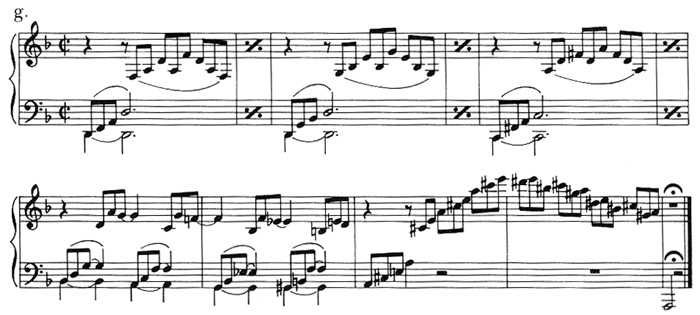
Example 12c transfers the dissonances to the bass to achieve greater instability, fills in the DB-flat space (while avoiding parallel fifths), reinforces the arrival at the cadence by approaching the V through its own VII7, and alters the third chord's F to F-sharp to make the next G different from the earlier one and the motion to it more impelling. Now the F-sharpGF exchange sets up the idea of chromatic alteration, immediately put to use by altering the newly added E in chord [sic] to E-flat, thus eliminating the repetitive EE soprano at the cadence, while producing at the same time an E-flatDE pattern that is an inversion of the implicit F- sharpGF of Example 12d.
Example 12e adds suspensions to the latter half of the segment to sustain the intensity created by the dissonances in the first half. The newly added Neapolitan sixth and diminished seventh chords now take the time that had been allotted to the originally penultimate III6 chord. In order to maintain the rhythmic intensity needed, the four chords preceding the cadence are assigned half a time unit each; the harmonic rhythm here has now become four times faster than the opening.
Example 12f arpeggiates the block chords of Example 12e. Comparing this (my) unimaginative realization with Mozart's own Example 12g, is most helpful; e.g., in Mozart's version the D that starts the alto level (measure 1) arrives just on the third quarter. However, the soprano's first note, F, is metrically unstressed and placed an octave higher than a straight descent would have produced. This rhythmic nuance creates a new asymmetrical rhythmic impulse that projects the melodic F. Also, the awkwardness of my version's measure 7 is noteworthy; but note how Mozart uses the resolving "lower neighbors" in measure 10 to create a rhythmic imbalance that also summarizes and intensifies the by now motivic chromaticism while also preparing for later harmonic changes (e.g., in measures 13, 17, 18, 21 and the cadenza in 44). Other comparisons are left to the reader.
Example 13 represents a similar exercise.
Ex. 13.



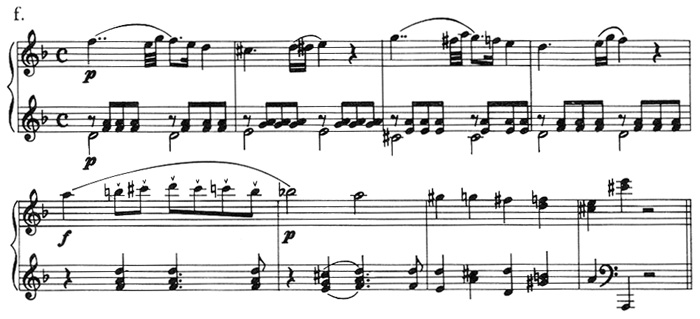
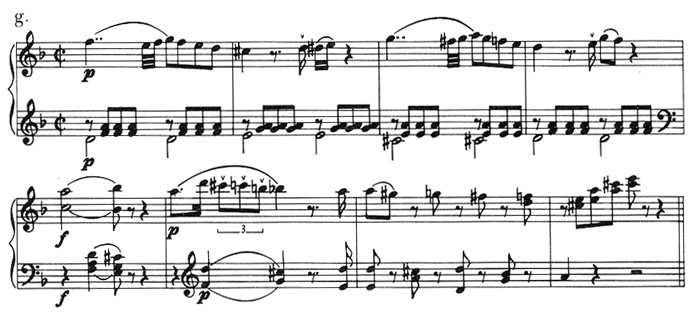
Example 13a takes the same I-V motion and soprano line, but moves the bass up instead of down to A, fills up the inner voices and again approaches the V through its own VII7 to reinforce that arrival and to keep the bass moving to A. Again, durations are assigned to increase the activity before—and restore the original timing at—the cadence. Reflecting the large in the small, Example 13b makes the FAE of the soprano's overall motion into a motive, using it to elaborate, in sequence, the F, G, and A of the soprano's structure. Note that here the second G is not approached through the F-sharp, its leading tone, and that no F-sharpGF pattern results that would continue to the E-flatDE inversion. Also the direct motion of the bass now requires fewer chords, and the E-flat in the soprano is omitted.12 Example 13c is a subtler, denser version of Example 13b; each step of the soprano is elaborated with a local motive. The FC-sharpE shape is the retrograde inversion of the source motive, FAE, modified by the harmonically impelled change of C to C-sharp; but the advantage of this variant is that it is a summary of the total motion of the introduction's treble, Example 13d.
The next step in the sequence, clearly heard as a variant, again uses the perfect fourth (GD) instead of the diminished fourth (FC-sharp), affirming the derivation of FC-sharpE from the introduction's FAE. Then the variant elaborating the A inverts the retrograde inversion that has now been used twice and arrives at an exact retrograded intervallic replica (perfect fourth and major third) of the referent FAE motive.
The descending line at the end of the segment repeats the ideas of quickening the rate of chord change (still not using the E-flat) and using a series of chromatics to increase the instability just before the cadential resolution of harmonic motion.
Example 13e embellishes the motive with dissonances and intensifies the climactic A.13 Examples 13f and 13g are variant realizations of Example 13e, mine (13f) substituting unaccented dissonances for comparison with the more evocative accented ones that Mozart uses (Ex. 13g), and annihilating the rhythmic elegance Mozart achieves in the last half of the segment.
The inclusion in analyses of aesthetic reasoning may very well be a valid response to students and others who say, after seeing an analysis, "But that's not why it's beautiful!" or perhaps "So what?" Musicological information, e.g., what external ideas the composer (may have) had in mind, what an event signifies extramusically, may indicate why something of a certain kind occurs in a piece; but analysis and musicology are after all complementary, not identical or substitute disciplines. Analysis—concerned with the significance of the particular event within the given musical content, with what in the music itself is compelling—must address how an idea, if there, is transformed into a musical discourse that makes internal, medium-specific sense, regardless of intention or references. The existence, or absence, of a program never makes a piece better than its content.
Art's content has richness. Dogmatic freshmen, than whom no one knows more, often have an arrogance matched only by their ignorance. But in art and in science, doubt, questioning and controversy lead to insight. I presented some students with a poem and, as was done with the variant versions of the Schubert and Mozart pieces discussed here, my own rend(er)ing of it which eliminated all specifically artistic usage, subtlety and connotative amplification. Instead of the comparison I had hoped for, they all declared a preference for mine, and for the same reason: it was clearer, i.e., it was easier to understand and had only one dimension, simply denotative. After discussion of the original's specifically poetic thought- and response-evoking content and of the aesthetic principles involved, however, they perceived where my version lacked poetry and had substituted clumsiness for grace. A comparison of a conjectured but still possible realization of a given artistic structure with the composer's own ought to reveal why the creative choices, inviting questioning, were good ones.
Showing structure, therefore, is not enough. Corrette's piece, for example, does not suffer re-examination well. Mozart's works do. Each structural layer has its functions. The background gives music direction and overall coherence, the middle grounds provide identifiability, and the foreground details make the music vivid. To perceive adequately the relationships within each layer and among them, and the interdependence, professionals and laymen require a set of (learned) aesthetic principles, experience and sensitivity, a developed intuition and ear, intelligence and wit, imagination and taste. There are standards; we who care have to nurture them.
1Edward T. Cone, "Beyond Analysis," Perspectives on Contemporary Music Theory, Benjamin Boretz and Edward T. Cone, editors (New York: Norton, 1972), pp. 72-90.
2See Jerome S. Bruner, On Knowing: Essays for the Left Hand (Cambridge: Harvard University Press, 1963), pp. 1-30, and especially pp. 14 and 18 for an enlightening discussion of "effective surprise."
3See Robert Scholes, Structuralism in Literature (New Haven, 1974), pp. 27-28 and 156-157 for a discussion of "duplicity," and Abraham Kaplan, "Referential Meaning in the Arts," Problems in Aesthetics, Morris Weitz, ed. (London: Collier-Macmillan, 1970), pp. 289-90 for a description of "metaphor."
4In John Rahn's "Logic, Set Theory, Music Theory," College Music Symposium Vol. 19, No. 1 (Spring 1979), particularly astute are his opening sentence, p. 114 and the footnote on p. 124.
5Persistent confusion seems to make it still necessary to acknowledge that of course one need not know the names of musical relationships in order to hear them; competent listeners just recognize them, consciously or intuitively, when they occur and recur.
6Jerome S. Bruner, op. cit., p. 21.
7The error of opposing intuition and analysis, like those of opposing thought and emotion or technique and expressivity, is unfortunately a common one, even among those who should know better. See for example Melvin Rader and Bertram Jessup, Art and Human Values (Englewood Cliffs: Prentice-Hall, 1976), p. 42.
8A line from Alexander Pope's poem An Essay on Criticism, Part II reads, "The sound must seem an Echo to the sense."
9Note that no reference is made here to "re-living" an experience associated with music, i.e., listening again to a piece that has accrued extra-musical memories, e.g., "They're playing our song, dear!" Reactions like these are conditioned reflexes rather than aesthetic responses.
10See also Edward Levy, "Analysis Applied to Performance," College Music Symposium Vol. 19, No. 1 (Spring 1979), p. 133.
11Heinrich Schenker, Der Tonwille (Vienna: Vol. 10 of the "Gesamtfolge," October 1924), pp. 25-29, and the "Urlinientafel" in the appendix.
12For a discussion of this "missing" E-flat see Oswald Jonas, Das Wesen des musikalischen Kunstwerk (Vienna: Im Saturn-Verlag, 1934), pp. 16-17.
13See also Feliz Salzer, Structural Hearing (New York: Dover Publications), II, 60.


